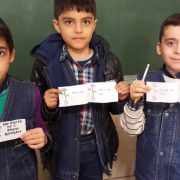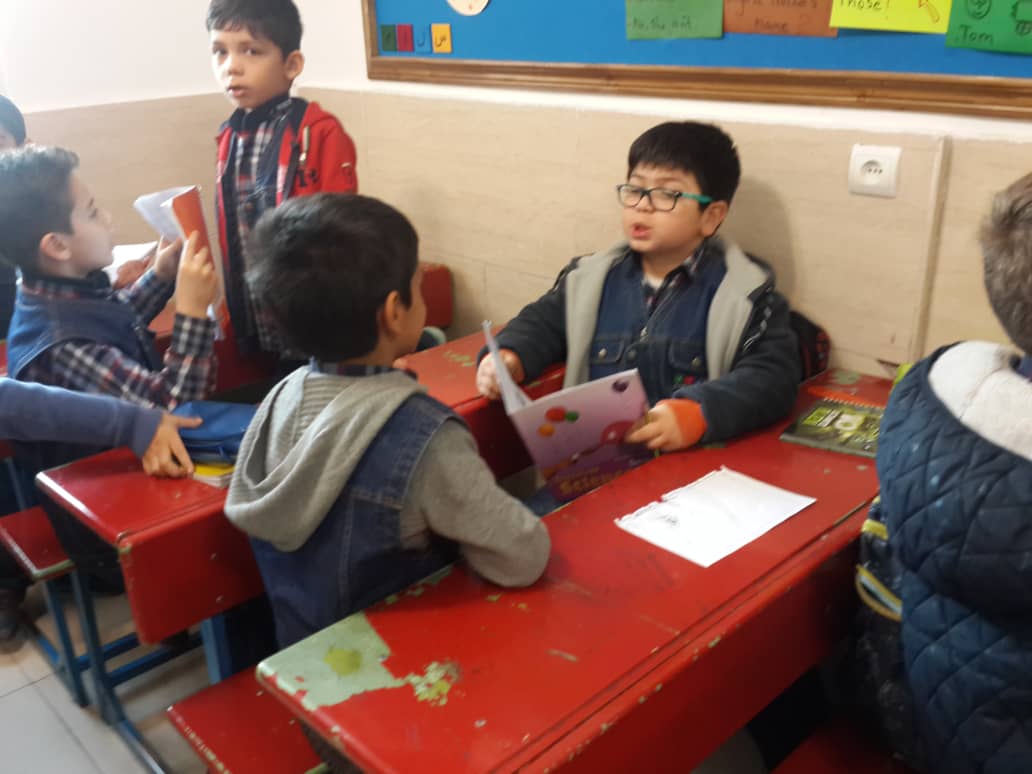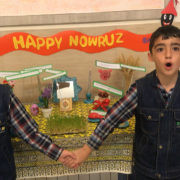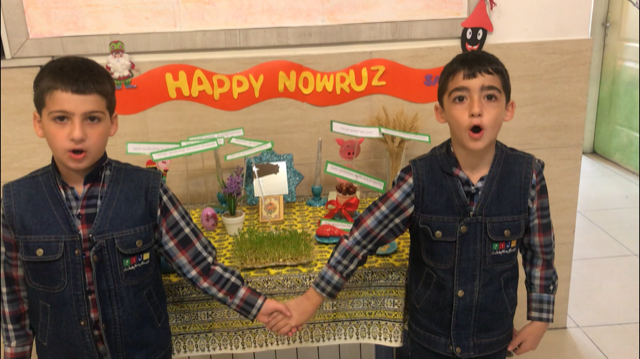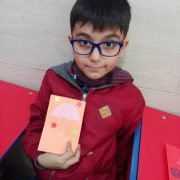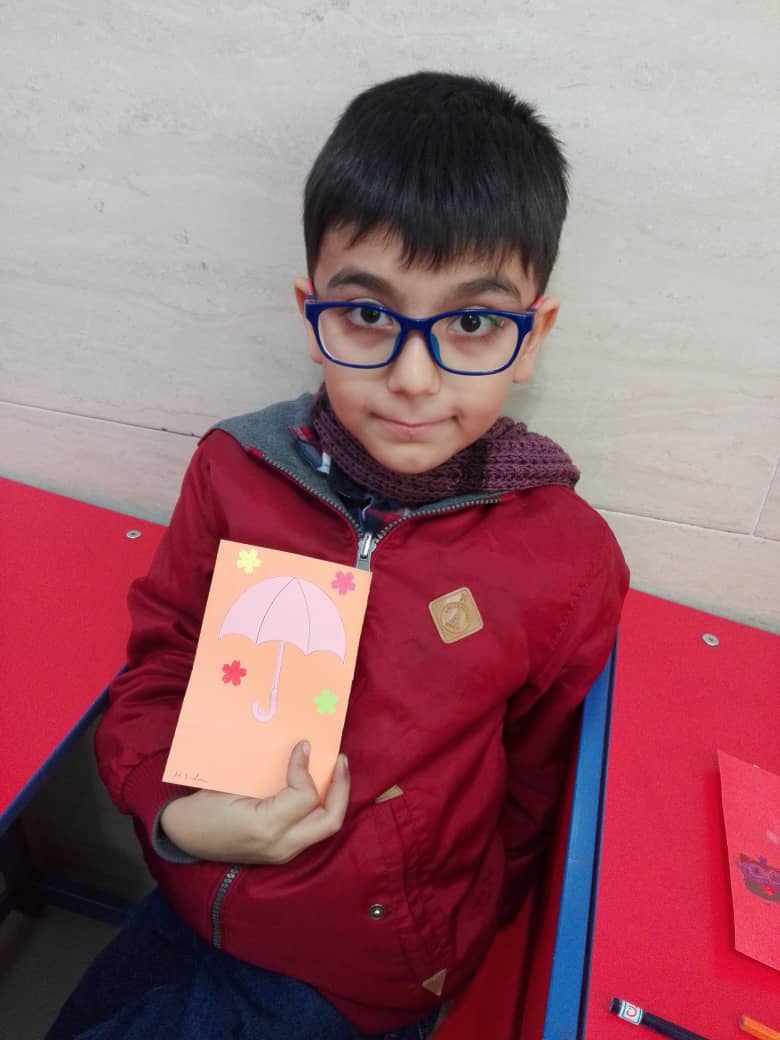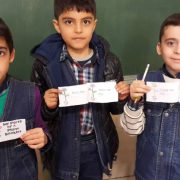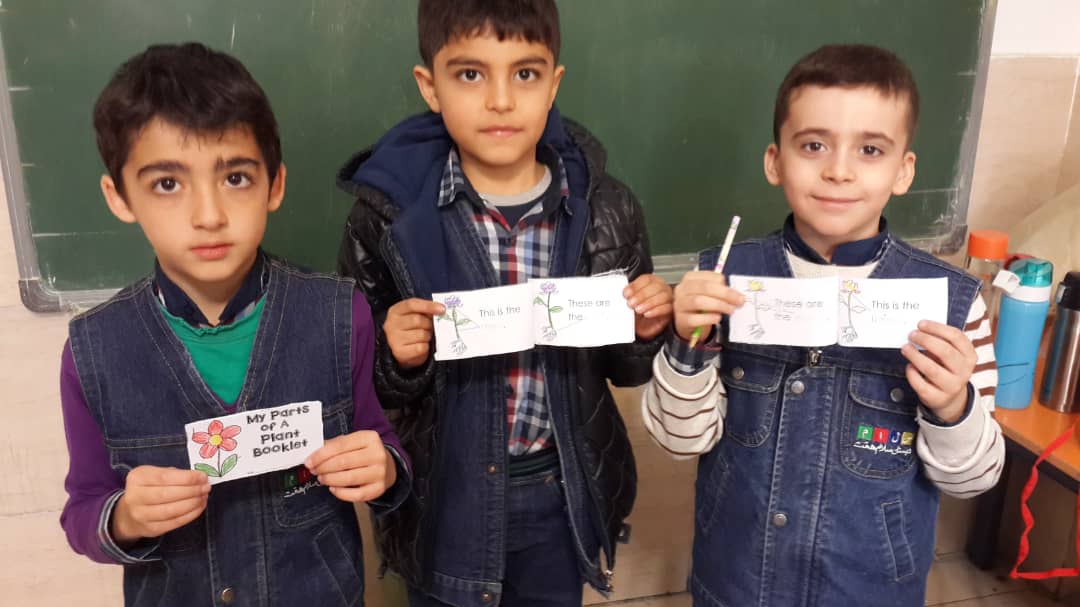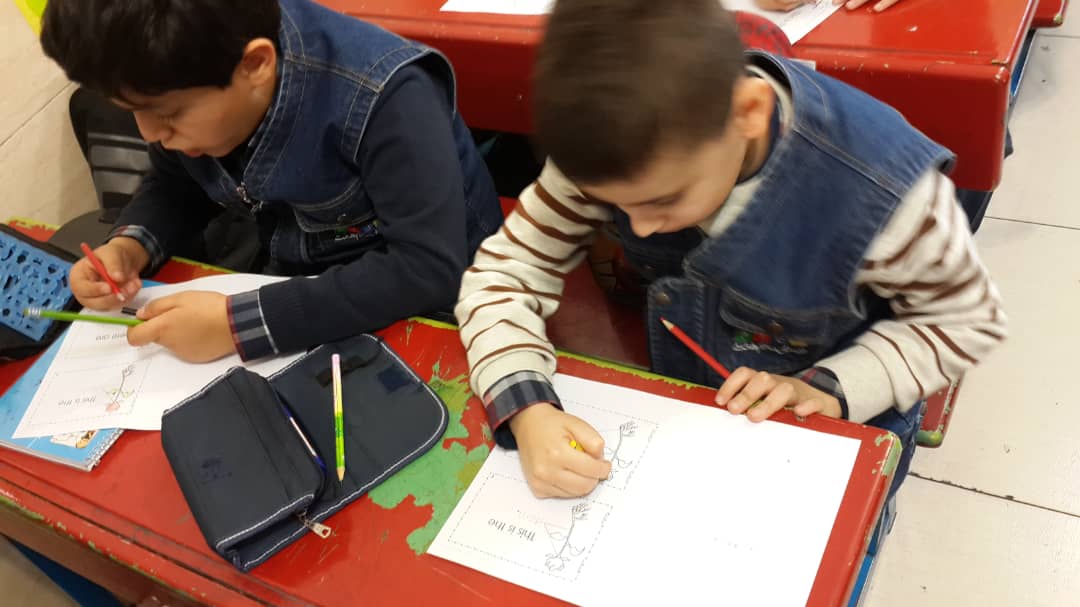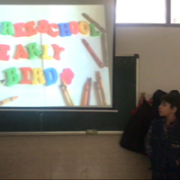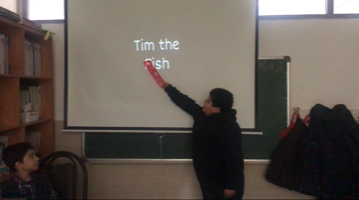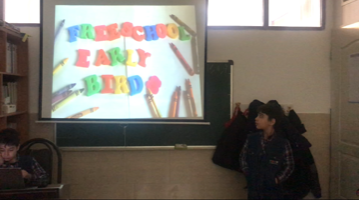Newsletter- Ordibehesht98- Ms. Malek
/در Grade TwoDear parents:
You are kindly informed that in our English class these subjects have been covered in one month since 6th April to 22nd May.
| Skills | Contents |
| Reading | · Reading and understanding captions of key words.
· Reading and understanding chant and song text. · Reading and understanding speech bubbles. · Reading and understanding speech bubbles in a picture story. · Reading and understanding sentences · Reading and understanding a recipe · Blending individual sounds and letters to create words · Reading and understanding a cultural text about packed lunches · Reading and understanding a personalization text. · Reading and understanding an information poster. · Reading and understanding a cultural text about faces in art. |
| Writing | · Writing key words.
· Writing key words or phrases in a sentences. · Writing answers to questions. · Writing a basic recipe. · Writing a simple information poster. · Writing a personalization text |
| Listening | · Understanding a dialogue
· Understanding chants and songs · Following instructions · Understanding and responding to questions · Understanding and identifying food. · Understanding and identifying different pictures. · Can understand a story. · Understanding activities in progress. · Understanding a process (plant life cycle) |
| Speaking | · Chanting and singing the unit chant and songs
· Understanding and identifying food. · Being able to ask and answer about likes and dislikes with food. · Being able to act out a story · Being able to pronounce j, ss, v and w correctly · Being able to ask and answer questions about food. · Being able to describe food which is good and bad for us. · Being able to ask for food you want and order from a menu. · Being able to describe what people are doing. · Being able to ask and answer about activities in progress. · Being able to describe a scene. · Being able to pronounce qu, x, y, z and zz correctly |
| Vocabularies |
| · Food: cheese, lemonade, bread, chicken, meat, salad, juice, fruit, yoghurt, milk, sandwich, water, chocolate, honey, vegetables, ice cream, cake
· CLIL ( social sciences (Food): chips, carrots · Culture (packed lunches): packed lunch, sushi, rice. · Vocabulary: climb a tree, eat a sandwich, play on the swing, feed the ducks, play on the slide, walk, swing, play on the roundabout, fly, look at the birds, catch a ball, win a match, throw a ball · Nouns: tree, flower, bird. · CLIL (Science): grow, seed, soil, plant, water, sunshine · Culture (world sports): gymnast, ballet dancer, football player, stretching |
| Structure |
| · I like (salad) and (meat).
· I don’t like (bread) and (cheese). · Do you like (honey)? Yes, I do. No, I don’t. · He/ she likes (meat). · He/ she doesn’t like (meat). · Does she/ he like (fruit)? Yes, she does. No, she doesn’t. · It’s good/ bad for me! · What are you doing? · I’m (playing on the slide). I’m not (eating a sandwich). · What’s he/she doing? He’s/she’s (catching a ball). He/she isn’t (walking). |
| Extra Activity |
| · Songs: what are you doing today?
· Look for a photo · We’re at the park. · To consolidate the quest vocabulary · To review and consolidate language from the course · To learn vocabulary relating to Christmas · To learn about British culture · Target language: reindeer, Santa, sleigh, present, star, sack, stocking, card · Receptive language: Christmas tree · To learn vocabulary relating to Easter · Target language: hop, chick, egg, bunny, jump, turn around, wake up, fall down |
| Science |
| · Domestic animals
· Wild animals · The benefits of some domestic animals · Baby animals and their parents · The seasons |
| Maths |
| · Numbers
· Diagrams · Changes of things · More, fewer, equal to |
| Classroom language |
|
· Greeting the class · Hello. Hi! · Good morning. · How are you today? · Come in. · Sit down/ stand up, please. · What day is it today? · Is everyone here? · Is anyone away today? · Where is(Ali) today? · Starting the lesson · Are you ready? · Listen to (me). · Look at (me/ the board). · Take out your (books/ notebooks) · Open your book at page (5). · Open/ close the door/ window. · Be quiet, please! · Come to the front of the class. · Come to the board. · Come here. · Line up! · Repeat after me. · Wait a minute. · Hurry up! · Show me your (book ). · Draw/ color/ stick/ cut out · Write the answer on the book. · Let’s sing. · It’s break time! · Next! · Again! · Do you understand? · What do you think? · Are you finished? · What can you see? · Any questions? · Well done! · Excellent! · That’s correct! · Thank you! · Work in pairs. · Who’s your partner? · Tell me/ your friend · Ask me/ your partner · Put your books away · Tidy up! · Goodbye! · See you tomorrow! · I understand/ I don’t understand. · May I go to the toilet? · May I drink water? · I’m finished. · I’m sorry. |
نسخه فارسی:
والدین محترم
احتراماً به اطلاع میرساند مطالب ذیل طی فروردین و اردیبهشت ماه در کلاس زبان کار شده است.
| کلمات |
| · غذا
· فعالیت های بیرون از خانه و درون خانه · لغات مربوط به کریسمس و عید پاک |
| ساختار |
| · استفاده از does , do برای صحبت کردن درباره غذا
· استفاده از present continuous برای فعالیت های در حال اتفاق در زمان صحبت کردن |
| فعالیت جانبی |
| · کریسمس
· عید پاک |
| علوم |
| · حیوانات اهلی
· حیوانات وحشی · فواید بعضی از حیوانات اهلی · حیوانات و بچه هایشان · فصل ها |
| ریاضی |
| · اعداد
· نمودار · کمتر، بیشتر، برابر |
Newsletter- Ordibehesht98- Ms.Farahbakhsh
/در Grade TwoDear parents:
You are kindly informed that in our English class these subjects have been covered since 6th April to 22nd May.
| Skills | Contents |
| Reading | · Reading and understanding captions of key words
· Reading and understanding chant and song text · Reading and understanding speech bubbles · Reading and understanding sentences · Blending individual sounds and letters to create words · Reading and understanding a cultural text about packed lunches · Reading and understanding a personalization text |
| Writing | · Writing simple key words
· Writing simple key words in a sentence · Writing what they like/ don’t like |
| Listening | · Understanding a dialogue
· Understanding chants and songs · Understanding and identifying foods · Following instructions · Understanding and identifying different pictures |
| Speaking | · Singing the unit song (I like chocolate)
· Identifying food · Talking about likes and dislikes with food · Acting out a story · Pronouncing j, ss, v and w correctly · Describing food which is good or bad for us |
| Vocabularies |
| · Food: cheese, lemonade, bread, chicken, meat, juice, fruit, yoghurt, milk, sandwich, water, chocolate, honey, vegetables, ice cream, cake. |
| Grammar |
| · I like (salad) and (meat).
· I don’t like (bread) and (cheese). · Do you like (honey)? Yes, I do. / No, I don’t. · He/ She likes (meat). · He/ she doesn’t like (fruit). · Does he/she like (vegetables)? · It’s good/ bad for me. |
| CLIL |
| · Social sciences (Food): chips, carrots, burger
· Packed lunches: packed lunch, sushi, rice |
| Science |
|
· Review parts of the plant · Domestic animals: cat, parrot, fish, cow, donkey, lamb, dog, rooster, chick, goat, duck… · Wild animals: bear, snake, tiger, elephant, monkey, kangaroo….. · Animals and their babies · The benefits of animals · Seasons of the year · Solid, liquid, gas |
| Math |
|
· Numbers · Diagrams · Changes of things · More, fewer, equal to |
نسخه فارسی:
والدین محترم
احتراماً به اطلاع میرساند مطالب ذیل در فروردین و اردیبهشت ماه در کلاس زبان کار شده است.
| کلمات |
| · غذاها و خوراکی ها |
| دستور زبان |
| · I like (salad) and (meat).
· I don’t like (bread) and (cheese). · Do you like (honey)? Yes, I do. / No, I don’t. · He/ She likes (meat). · He/ she doesn’t like (fruit). · Does he/she like (vegetables)? · It’s good/ bad for me. |
| علوم |
| · اجزای مختلف گیاه
· حیوانات وحشی · حیوانات اهلی · حیوانات و بچه های حیوانات · فواید حیوانات · فصل های سال · حالات مختلف مواد : جامد، مایع، گاز |
Newsletter- Esfand 97-Ms. Malek
/در Grade TwoDear parents:
You are kindly informed that in our English class these subjects have been covered in one month since 20th February to 13th March.
| Skills | Contents | |
| Reading | · Reading and understanding captions of key words.
· Reading and understanding chant and song text. · Reading and understanding speech bubbles. · Reading and understanding speech bubbles in a picture story. · Reading and understanding sentences · Blending individual sounds and letters to create words · Reading and understanding a cultural text about different or unusual homes. · Reading and understanding a personalization text. |
|
| Writing | · Writing key words.
· Writing key words or phrases in a sentences. · Writing a description a room. · Writing answers to questions. · Being able to ask and answer questions about where you live. |
|
| Listening | · Understanding a dialogue
· Understanding chants and songs · Following instructions · Understanding and responding to questions · Understanding and identifying houses. · Understanding and identifying different pictures. · Can understand a story. |
|
| Speaking | · Chanting and singing the unit chant and songs
· Understanding and identifying rooms. · Being able to ask and answer about where you live. · Being able to identify public places. · Being able to act out a story · Being able to pronounce f, ff, l and ll correctly · Being able to ask and answer questions about houses. · Being able to describe his home. · Being able to describe a room. |
|
| Vocabularies |
| · At home: house, flat, garden, living room, kitchen, bathroom, bedroom.
· At home: sofa, cooker, bath, bed, fridge, TV, lamp, sink. · CLIL: public places, shop, library, park, zoo, café, playground. · Culture: different houses, houseboat, caravan. |
| Structure |
| · Where do you live?
· I live in a (house). I live in (Cairo). · Do you live in a (house)? Yes, I do. / No, I don’t. · Where is (Rita)? She is in the (kitchen). · Where are they? They are in the (garden). · Is there a (lamp) on the (table)? Yes, there is. / No, there isn’t. · There’s a (book) on/ under/ next to/ behind (the desk). · There are two books on/ under/ next to/ behind/ in (the bag). |
| Extra Activity |
|
Dear God, Thank you for the night and the early morning light. For rest and food and loving care and all that make the world so fair. Help us to do the things we should, To be to others kind and good. God bless me My mummy and my daddy, And my brothers and my sisters, My teachers and my friends and everyone. |
نسخه فارسی:
والدین محترم
احتراماً به اطلاع میرساند مطالب ذیل طی اسفند ماه در کلاس زبان کار شده است.
| کلمات |
| · اسم تعدادی کشور
· انواع خانه · بخش های خانه · مکان های عمومی · اسباب و اثاثیه خانه |
| ساختار |
| · استفاده از there is , there are برای صحبت کردن درباره اشیا در قسمت های مختلف خانه |
| فعالیت جانبی |
|
· دعای صبحگاه |
Newsletter- Esfand 97-Ms. Farahbakhsh
/در Grade TwoDear parents:
You are kindly informed that in our English class these subjects have been covered since 20th February to 13th March.
| Skills | Contents |
| Reading | · Reading and understanding captions of key words
· Reading and understanding chant and song text · Reading and understanding speech bubbles · Reading and understanding sentences · Blending individual sounds and letters to create words · Reading the story of spring (Spring is here) |
| Writing | · Writing simple key words
· Writing simple key words in a sentence · Writing a description of a room |
| Listening | · Understanding a dialogue
· Understanding chants and songs · Understanding and identifying animals · Following instructions · Understanding and identifying different pictures |
| Speaking | · Singing the unit song (Where’s the mouse?)
· Identifying rooms and furniture · Describing a room · Identifying public places · Asking and answering questions about where you live · Pronouncing f, ff, l, ll correctly |
| Vocabularies |
| · At home: house, flat, garden, living room, kitchen, bathroom, bedroom.
· Furniture: sofa, cooker, bath, bed, fridge, TV, lamp, sink. |
| Grammar |
| · Where do you live?
· I live in (a house). I live in (Brazil). · Do you live in a (flat)? Yes, I do. No, I don’t. · Where’s (Rita)? She’s in the (bedroom). · Where are (Waldo and Zak)? They’re in the (kitchen). · There’s a lamp on/ under/ next to/ behind the desk. · There are two books on/ under/ next to/ behind/ in the bag. |
| Science |
|
· Review plants and their needs: – water, air, soil, sunlight. · Parts of the plants: Stem, root, flower, leaf, leaves. · How does a plant grow |
نسخه فارسی:
والدین محترم
احتراماً به اطلاع میرساند مطالب ذیل در اسفند ماه در کلاس زبان کار شده است.
| کلمات |
| قسمت های مختلف خانه
· وسیله های خانه |
| دستور زبان |
| · Where do you live?
· I live in (a house). I live in (Brazil). · Do you live in a (flat)? Yes, I do. No, I don’t. · Where’s (Rita)? She’s in the (bedroom). · Where are (Waldo and Zak)? They’re in the (kitchen). · There’s a lamp on/ under/ next to/ behind the desk. · There are two books on/ under/ next to/ behind/ in the bag. |
| علوم |
|
· مروز گیاهان و نیازهای آنها ( آب، خاک، نور، هوا) · اجزای مختلف گیاه · چگونگی رشد گیاه |
Newsletter-Bahman97- Ms. Malek
/در Grade TwoDear parents:
You are kindly informed that in our English class these subjects have been covered in one month since 21st of January to 19th February.
| Skills | Contents | |
| Reading | · Reading and understanding captions of key words.
· Reading and understanding chant and song text. · Reading and understanding speech bubbles. · Reading and understanding speech bubbles in a picture story. · Reading and understanding sentences · Blending individual sounds and letters to create words · Reading and understanding a cultural text about an ostrich farm. · Reading and understanding a personalization text. |
|
| Writing | · Writing key words.
· Writing key words or phrases in a sentences. · Using correct punctuation. · Writing answers to questions. · Writing a personalization text. |
|
| Listening | · Understanding a dialogue
· Understanding chants and songs · Following instructions · Understanding and responding to questions · Understanding and identifying parts of the body. · Understanding and identifying actions. · Understanding and identifying objects or pictures. · Can understand a story. |
|
| Speaking | · Chanting and singing the unit chant and songs
· Understanding and identifying animals. · Being able to ask and answer about possession. · Being able to act out a story · Being able to pronounce b, h and u correctly · Being able to ask and answer questions about animals. |
|
| Vocabularies |
| · Pets: mouse, cat, parrot, rabbit, tortoise, wings, tail.
· Farm animals: cow, turkey, duck, goat, sheep, horse, hen. · Writing: question marks, full stops, commas. · Baby animals: bird, chick, kitten, puppy, goose, egg. · Ostrich farm: ostrich, fly, mother, father. · Phonics: bag, rug, hot, hat, red, rat, up, cup. |
| Structure |
| · It’s got a (tail). They’ve got (four legs).
· Has it got (wings)? Yes, it has. No, it hasn’t. · Have they got (tails)? Yes, they have. No, they haven’t got. · It’s (big). It isn’t (brown). · What’s this/that? It’s (a mouse). · Are they (small)? Yes, they are. No, they aren’t. · What are three major parts of our body? A. head. B. trunk. C. limbs. · How can you use your body parts? I clap with my hands, I point with my fingers, I kick a ball with my foot. · Name some plants. A. trees. B. grass. C. flowers. D. fruit · How do leaves look like? The leaves of different plants have different shapes. · What does a plant need to grow? It needs water, light, soil, air. · How does a plant grow? It grows from a seed, it becomes a young plant, it becomes bigger, it has flower, and it is a full-grown plant. · Count back from 20 to 1. · Which number is even? 2-5-11-9-7-8 · Which number is odd? 3-4-14-17-19-43 |
| Math |
| · Which one is odd number? 3-4-8
· Which one is even number? 4-5-9 |
| Extra Activity |
|
Dear God, Thank you for the night and the early morning light. For rest and food and loving care and all that make the world so fair. Help us to do the things we should, To be to others kind and good. God bless me My mummy and my daddy, And my brothers and my sisters, My teachers and my friends and everyone. |
نسخه فارسی:
والدین محترم
احتراماً به اطلاع میرساند مطالب ذیل طی بهمن ماه در کلاس زبان کار شده است.
| کلمات |
|
· حیوانات خانگی · توصیف حیوانات · حیوانات مزرعه · بچه های حیوانات · مزرعه شترمرغ |
| ریاضی |
| · اعداد زوج و فرد |
| علوم |
| · سه بخش اصلی بدن
· بخش های گیاه · نیازهای گیاه برای رشد · تفاوت های برگ ها |
| فعالیت جانبی |
| · دعای صبحگاه |
Newsletter-Bahman97- Ms. Farahbakhsh
/در Grade TwoDear parents:
You are kindly informed that in our English class these subjects have been covered since 21st January to 19th February.
| Skills |
Contents |
|
Reading |
· Reading and understanding captions of key words · Reading and understanding chant and song text · Reading and understanding speech bubbles · Reading and understanding sentences · Following speech bubbles in a picture story · Blending individual sounds and letters to create words · Reading and understanding a cultural text about an ostrich farm · Reading and understanding a personalization text |
|
Writing |
· Writing simple key words · Writing simple key words in a sentence · Using correct punctuation and capitalization · Completing a personalization text |
|
Listening |
· Understanding a dialogue · Understanding chants and songs · Understanding and identifying animals · Following instructions · Understanding a story ( the pig, Tim the fish) · Understanding and identifying different pictures |
|
Speaking |
· Singing the unit song (I’m Max) · Identifying animals · Asking and answering about possession · Giving instructions for others to follow · Pronouncing b, h, r and u correctly (bag, rug, hot, hat, red, rat, up, cup) |
| Vocabularies |
| · Animals: mouse, cat, parrot, rabbit, tortoise, wings, tail, cow, turkey, duck, goat, sheep, horse, hen.
· Writing vocabularies: question mark, comma, full stop. · Baby animals: bird=chick, dog= puppy, cat= kitten. · Ostrich farm: ostrich, fly, mother, father.
|
| Grammar |
| · It’s got a (tail). They’ve got (four legs).
· Has it got (wings)? -Yes, it has. – No, it hasn’t. Have they got (tails)? – Yes, they have. – No, they haven’t. · It’s (brown). It isn’t (big). · Is it (green)? -Yes, it is. – No, it isn’t. · They’re (small). · Are they (small)? -Yes, they are. – No, they aren’t. |
| Science |
| · Plants and their needs:
– water, air, soil, sunlight. |
نسخه فارسی:
والدین محترم
احتراماً به اطلاع میرساند مطالب ذیل در بهمن ماه در کلاس زبان کار شده است.
| کلمات |
| · اسامی حیوانات
· اسامی بچه های بعضی از حیوانات · علائم نگارشی · کلمات مربوط به مزرعه شترمرغ |
| دستور زبان |
| · It’s got a (tail). They’ve got (four legs).
· Has it got (wings)? -Yes, it has. – No, it hasn’t. Have they got (tails)? – Yes, they have. – No, they haven’t. · It’s (brown). It isn’t (big). · Is it (green)? -Yes, it is. – No, it isn’t. · They’re (small). · Are they (small)? · -Yes, they are. – No, they aren’t. |
| علوم |
| · گیاهان و نیازهای آنها ( آب، خاک، نور،هوا) |

